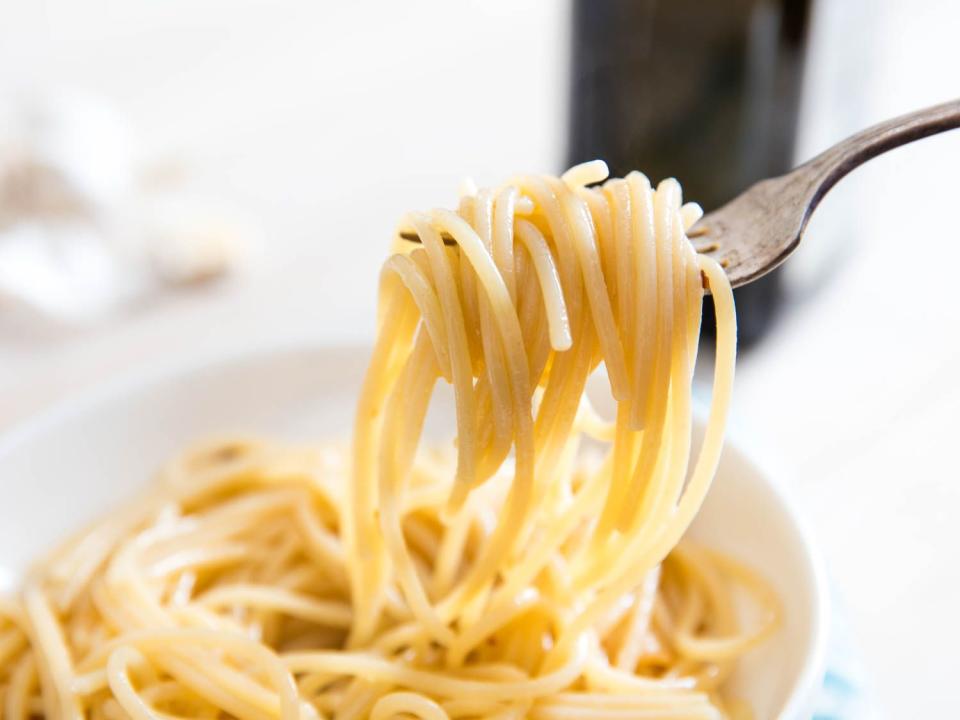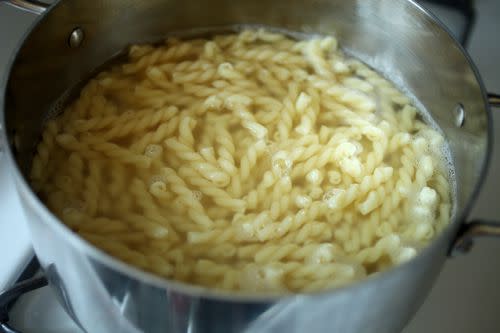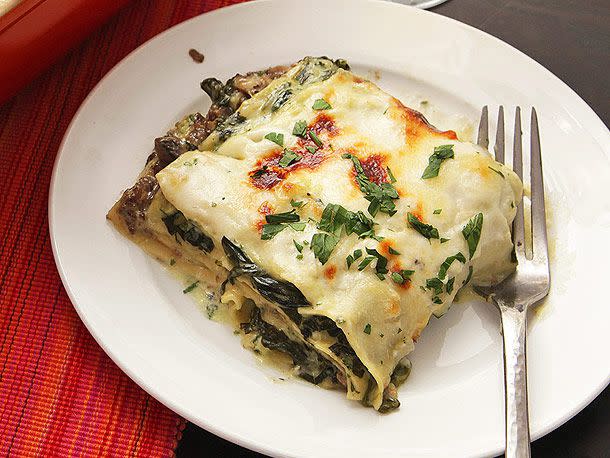Can I Start Pasta In Cold Water? | Ask The Food Lab
An examination of why boiling a big pot of water is not always necessary for successfully cooking some pasta shapes.

Serious Eats / Vicky Wasik
"Can you start cooking pasta in cold water? If not, why?"
—Sent by Robis
If you're a long-time reader of The Food Lab, you might remember an article I wrote that addresses this very question a few years back. I feel it's important enough to warrant a recap.
It's a great question, and one that I've got a personal history with. One of my very first jobs in a restaurant was as a cook at No. 9 Park, a modern Italian/French restaurant in Boston. I spent a good nine months or so working the pasta station, where it was drilled into my head that the water in the pasta machine better be boiling before I put the pasta into it or it won't cook properly and will stick together all mush-like, creating a disturbance in the forza as if millions of Italian grandmothers suddenly cried out in terror and were suddenly silenced.
I never questioned it because it wasn't my place to. It wasn't until about a decade later, when I saw how my not-yet-wife cooks her pasta, that I started realizing that maybe the rule wasn't so hard and fast as it was made out to be. Her method? Cover pasta with cold water in a relatively small pot. Put it over a burner. Stir it a few times as it heats up, then leave it alone.
And it comes out perfectly fine.

Serious Eats / J. Kenji López-Alt
Why is this? It's because cooking pasta is actually a two-phase process: hydration and cooking. Normally, the two go hand in hand—the pasta absorbs water as it cooks. But it doesn't have to be.
Turns out that whether you start with hot or cold water, pasta will still absorb just about the same amount. To prove this, I cooked a few batches of pasta side-by-side in various amounts of water, and starting at various temperatures. No matter how I did it, each batch of pasta ended up soaking about 75 percent of their dry weight in water and indistinguishable from one another each other in a taste test.
Indeed, the pasta cooked in a small volume of water had a distinct advantage: the pasta water contains more starch, making it more effective at tightening up a sauce and getting that sauce to cling to the cooked pasta.
The fastest, most energy-efficient way I know to cook dry pasta is to place it in a medium saucepan, cover it with salted water by an inch or two, place it over a burner set on high and heat it, stirring every few minutes. Once it comes to a boil, put a lid on the pot and turn the heat to the lowest setting. Even if it loses its boil, the pasta will still continue to cook so long as it's kept above 180°F or so. Follow the back of the box for timing, starting the timer as soon as it comes to a boil, and subtracting a minute or two from the recommended time.
Want some more cool info? Read on!
Does a Large Pot Boil Faster?
Want to hear something even more interesting? Folks will occasionally say that "using a large volume of water will help the water come back to a boil more quickly."
Back up a minute there, because you know what? This is untrue. In fact, in most real-world cases, the exact opposite is the case.
But how is this so? Doesn't adding a fixed amount of pasta to a small pot cause the temperature in that post to drop more than it does in a large pot? Therefore doesn't the large pot come back to a boil more quickly? Let's examine the ideal scenario first.
You have two pots of water. One has 1 quart of water, the other has 1 gallon—four times as much. Both are sitting on top of identical burners and are at a full, 212°F (100°C) boil. Now add a cup of dry pasta to each one. Because the pasta is at room temperature, it will cause the temperature of the water in each pot to drop, and the water in the quart-sized pot will drop four times more than the one in the gallon-sized pot.*
*Ah ha!, you say. If the temperature fell four times lower in the small pot, it must take four times longer for it to come back up to a boil!
""the two pots of water return to a boil at the exact same time!""
The problem with this line of reasoning is that it doesn't take into account the fact that it takes four times less energy to raise a quart of water by one degree as it does to raise a gallon of water. Since a burner puts out energy at a constant fixed rate, the small pot, which needs to cover a temperature gap four times as great as the large pot, serendipitously also heats up four times faster. This means that the two pots of water return to a boil at the exact same time!*
*For the record, it's also the same amount of energy and time required to bring a cup of dry pasta from room temperature to 212°F.
In the real world, the "big pots boil faster" camp is even more wrong. See, the larger a pot, the greater its surface area. And the greater the surface area of a hot body, the more rapidly it can lose heat to the outside environment. How does this affect heating?
Let's say your burners put out heat energy at a very respectable 10,000 BTU. Meanwhile, your small pot might be losing heat energy to the air in the kitchen at, say, 1,000 BTU, giving you a net energy input of 9,000 BTU. A large pot, on the other hand, will lose heat more rapidly due to its larger surface area. Let's say, 2,000 BTU. Your burner is still exactly the same, putting out 10,000 BTU, which means that with a large pot, the net energy input is only 8,000 BTU.
Thus, a large pot will actually return to a boil more slowly than a small pot.*
* This doesn't even take into account the heat loss from evaporation, which again compounds the case against large pots.
Surprised?
Take It to the Limit: Soaking Pasta
The folks over at Ideas In Food have written about "1-minute pasta." The trick? Soak dried pasta in water until it is fully hydrated. Once that's done, all you've got to do is cook the pasta—say, by tossing it in hot sauce—and it comes out as if it had been cooked and hydrated all at the same time. The beauty in this method is that by pre-soaking pasta and having it sitting in your fridge, you don't have to bring a pot of water to a boil every time you want to eat it. Pasta prep becomes almost immediate.
It's how I generally cook my pasta these days: start the pasta soaking while I prepare a sauce or other ingredients. By the time the sauce is hot and ready, the pasta is hydrated, and all I've got to do is drop it in the sauce and let it finish cooking. Easy!

Serious Eats / J. Kenji López-Alt
I also use this method whenever I'm putting together a lasagna, like this creamy spinach and mushroom version.
The Exceptions
There are times when you do want to start with a large pot of already-boiling water. The first is when cooking fresh pasta. Because fresh pasta is made with eggs, if you don't start it in boiling water, it won't set properly, causing it to turn mushy or worse, disintegrate as it cooks.
The second exception is with long, skinny pasta shapes like spaghetti or fettucini. Because they stack together so easily, it's more likely than with other pasta shapes that they will stick together. As the pasta heats and absorbs moisture, starches on its surface gelatinize, becoming sticky. If the strands are stuck together when this happens, they'll fuse together permanently, especially in a smaller pot where you have less room to maneuver them.
So to cook long, skinny pasta, you've got two real options. First is the traditional method: A large pot of salted boiling water gives you plenty of room to move the pasta around, limiting the risk of it sticking together.
Your other option is to use the pre-soak method. Because starch needs to be heated to gel properly, soaking pasta in cold water will allow you to hydrate it without worrying about it sticking together. Once it's fully hydrated, you've just got to finish it off in your sauce and you're ready to serve.
For a more detailed answer to this question, check out my old article below.
Read More: A New Way to Cook Pasta? | The Food Lab
May 2013
Read the original article on Serious Eats.

